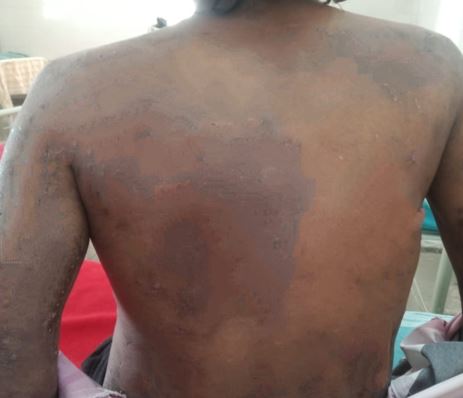Ayurvedic management of Kitibha Kushta (Guttate Psoriasis) with Virechana and Shirodhara - A Single Case Study
DOI:
https://doi.org/10.21760/jaims.10.6.49Keywords:
Kitibha Kushta, Guttate Psoriasis, Virechana, Shirodhara, Psoriasis Area and Severity Index (PASI), Dermatology Life Quality Index (DLQI)Abstract
In Ayurveda, skin diseases are classified under the heading "Kushta", which is further divided into Mahakushta and Kshudra Kushta. Kitibha Kushta falls under Kshudra Kushta and is characterized by small, round, and scaly skin lesions. Kushta Roga, a dermatological disorder that includes psoriasis, is a chronic condition marked by recurrence, immune-mediated skin inflammation, and scaling, thickened, and rough skin lesions accompanied by itching. This condition affects both genders equally, with a worldwide prevalence of 1-2%, and can significantly impact the physical, emotional, and psychosocial well-being of affected individuals. A 46-year-old male patient with a 3-month history of Kitibha Kushta underwent treatment with Virechana and Shirodhara for 30 days. The patient's symptoms were assessed using the Psoriasis Area and Severity Index (PASI) and the Dermatology Life Quality Index (DLQI) before and after treatment. The results showed significant improvement, with an 84% reduction in PASI score and a 90% reduction in DLQI score. The patient reported a marked reduction in itching, scaling of the lesions, and anxiety. This case study suggests that Ayurvedic management using Virechana and Shirodhara may be an effective treatment option for Kitibha Kushta. Moreover, Ayurvedic medicines have been providing a safe and effective approach to managing Kitibha Kushta for thousands of years.
Downloads
References
Srikanthamurthy KR. Ashtanga Sangraha. 5th ed. Varanasi: Chowkhamba Orientalia; Sharirsthana 5/16–18. p. 61–2.
Agnivesha, Charaka, Dridhabala. Charaka Samhita, Chikitsasthana. Pt. Shastri K, Chaturvedi G, editors. Varanasi: Chaukhamba Bharti Academy; 2002. Hindi Vidyotini Commentary. Part 1.
Trivikramaji Y, editor. Charaka Samhita, Sutrasthana 28/11. Varanasi: Chaukhamba Prakashana; 2013. p. 179.
Berekmeri A, Mahmood F, Wittmann M, Helliwell P. Tofacitinib for the treatment of psoriasis and psoriatic arthritis. Expert Rev Clin Immunol. 2018;14(9):719–30.
Kahn J, Deverapalli SC, Rosmarin D. JAK-STAT signaling pathway inhibition: a role for treatment of various dermatologic diseases. Semin Cutan Med Surg. 2018;37(3):198–208.
Parisi R, Symmons DP, Griffiths CE, et al. Global epidemiology of psoriasis: a systematic review of incidence and prevalence. J Invest Dermatol. 2013;133(2):377–85.
Dupire G, Droitcourt C, Hughes C, Le Cleach L. Antistreptococcal interventions for guttate and chronic plaque psoriasis. Cochrane Database Syst Rev. 2019;3(3):CD011571.
James WD, Berger TG, et al. Andrews' Diseases of the Skin: Clinical Dermatology. Philadelphia: Saunders Elsevier; 2006.
Louden BA, Pearce DJ, Lang W, et al. A simplified Psoriasis Area Severity Index (SPASI) for rating psoriasis severity. Dermatol Online J. 2004;10(7):7.
Lewis V, Finlay AY. Ten years’ experience of the Dermatology Life Quality Index (DLQI). J Invest Dermatol Symp Proc. 2004;9(2):169–80. doi:10.1111/j.1087-0024.2004.09113.x.
Modasia KH, Kaliyadan F. Digital tools for assessing disease severity in dermatology. Indian Dermatol Online J. 2022;13:190–8. doi:10.4103/idoj.idoj_636_21.
Tewari PV. Caraka Samhita, Cikitsasthana. 1st ed. Varanasi: Chaukhambha Vishwabharati; 2019. p. 295.
Tewari PV. Caraka Samhita, Cikitsasthana 15/96–97. 1st ed. Varanasi: Chaukhambha Vishwabharati; 2019.
Mishra AS. Abhinav Bhaishajyakalpana Vigyan. Varanasi: Chaukhamba Surbharati Prakashan; 2010. p. 186–7.
Rao PG. Sahasrayogam. Reprint ed. Varanasi: Chaukhambha Publications; 2019. p. 501.
Rao PG. Chakradatta Chikitsa Sangraha, Kushtadgikara sloka 33. Varanasi: Chaukhambha Orientalia; p. 132.
Anonymous. Bhaishajya Ratnavali, Amlapitta Chikitsa 56/25–29.
Sastry JLN. Dravyaguna Vijnana. Vol 2. Reprint. Varanasi: Chaukhamba Orientalia; 2014. p. 169.
Rao PG. Chakradatta Chikitsa Sangraha, Kushtadgikara sloka 33. Varanasi: Chaukhambha Orientalia; p. 457.
Vagbhata. Astanga Hridaya, Chikitsa Sthana 19/59–60. OR Charaka Samhita, Chikitsa Sthana 7/91–92.
Rao PG. Chakradatta Chikitsa Sangraha, Kushtadgikara. Varanasi: Chaukhambha Orientalia; p. 468.
Agnivesha. Charaka Samhita with Ayurveda Dipika commentary by Chakrapanidatta. Revised by Charaka and Dridhabala. Acharya YT, editor. Varanasi: Chaukhamba Sanskrit Sansthan; 5th ed. 2001. Chikitsa Sthana 7/41. p. 452.
Singh V, Srivastava AK. Management of Psoriasis (Ekakushta) with Panchakarma Chikitsa. Int J Ayurveda Pharma Res. 2015;3(1):22.















